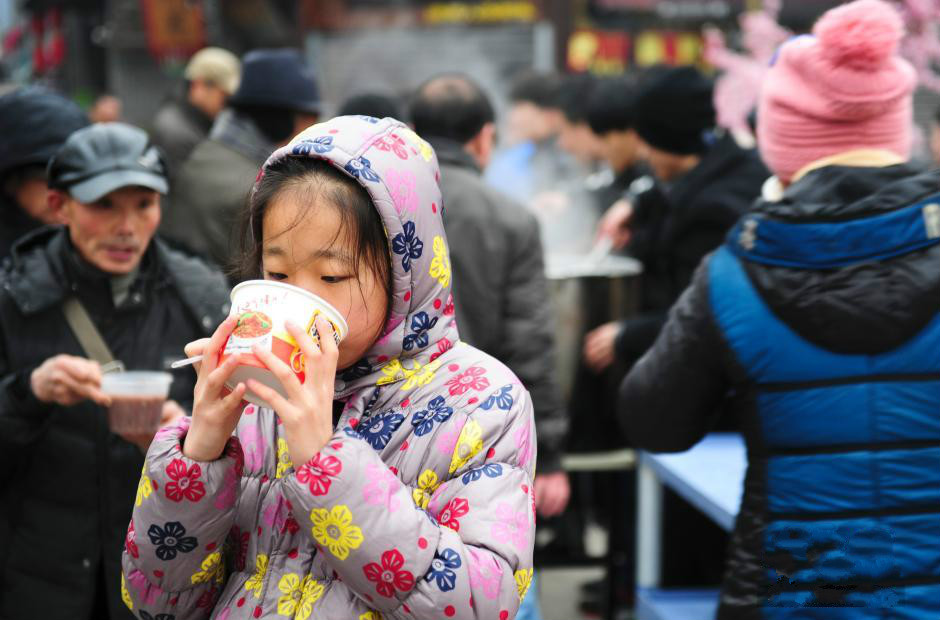Laba Rice Porridge Festival influenced by Buddhism

The most important tradition on the Laba Festival is making and eating delicious rice porridge. This custom has persisted for more than 1,000 years in China.
“Kid, kid, don’t be greedy; Spring Festival comes after Laba.” This Chinese saying indicates that the most significant festival in the twelfth month of the lunar year is the Laba Rice Porridge Festival or Laba Festival, because the Spring Festival comes after it.
Since the pre-Qin period, people celebrated on the eighth day of the twelfth lunar month to offer sacrifices to ancestors and deities, praying for a good harvest and good luck in the next year.
More than the worship, ancient people also held ceremonies to exorcise evils and epidemic diseases on the Laba Festival. In prehistoric times, driving off evil and ghosts was how people practiced medicine. Even today, people in Xinhua County, Hunan Province, still beat drums to expel diseases as a custom on the Laba Festival. Due to similar festival themes and the dates on the lunar calendar, Chinese people have become accustomed to counting down toward the Spring Festival season after the celebration of Laba.
The custom of eating rice porridge during the Laba Festival has lasted for more than 1,000 years in China. It originated from the Song Dynasty. At that time, the court, feudal officials, temples and common people all made Laba congee at the festival. In the Qing Dynasty, this custom prevailed across the country. At court, emperors, empresses and princes granted Laba porridge to all ministers, attendants and maids, and provided rice and fruits for monks in every temple. As for ordinary members of the public, every household made rice porridge. Some congees were offered to gods and ancestors, some were eaten during the family reunion dinner and some were sent to relatives and friends as gifts. If there were still some leftovers of Laba porridge after several days, it would be a good sign that the family would be richer in the coming year. People believe that if they share Laba porridge with the poor, one good turn deserves another.
Jiang Yuxiang, a professor of the College of Literature and Journalism at Sichuan University, indicates that the Laba Festival had not occurred on a fixed day until the Southern and Northern dynasties. The Jingchu Chronicle, the earliest systematic record of local folk customs in the area of modern Hubei province in the 6th century, stated that the festival was put on a fixed time on the eighth day of the twelfth month at that time.
Moreover, the Laba Festival was deeply influenced by Buddhism. Hu Fang, an associate research fellow at Qinghai Academy of Social Sciences, said that Buddhism was introduced to China after the Han Dynasty, and that since then, some people regard the day of the Laba Festival as the enlightenment day of the Buddha. As such, many customs of the festival are related to Buddhism.
Even in some places, Laba congee is called “Buddha’s porridge,” and rice, red bean, Chinese date, walnut meat and other ingredients in the porridge represent the Eighteen Arhats of the Buddha. The meaning of such a bowl of porridge is closely connected with traditional Chinese values which integrate the thoughts of Confucianism, Buddhism and Taoism. Also, it reflects common people’s genuine wishes for family reunion, happiness, safe and sound life.
However, folklorists say that the pace of modern life has cast a pall over the celebration of the Laba Festival in recent decades. But after the Laba Festival, most households begin to prepare for the coming of the Spring Festival.
In addition to eating Laba porridge on the Laba Festival, people in some specific areas also make Laba tofu, Laba garlic and Laba noodles to celebrate the festival. For instance, it is a tradition for Han people in North China to soak garlic in vinegar and put them in a big jar on the Laba Festival. The pieces of garlic in vinegar turn green and look like little pieces of jade. On the Spring Festival, people open the jar and eat dumplings with the Laba garlic, which symbolizes a good fortune.
